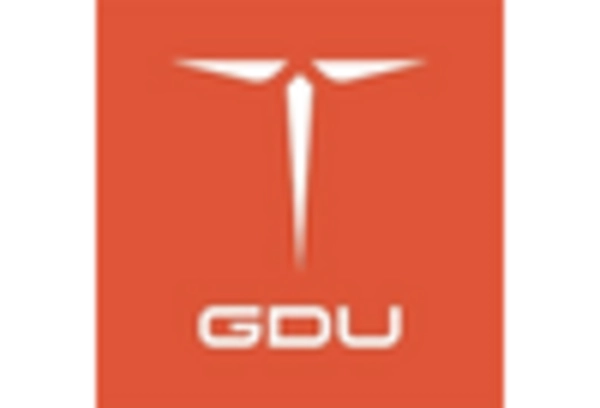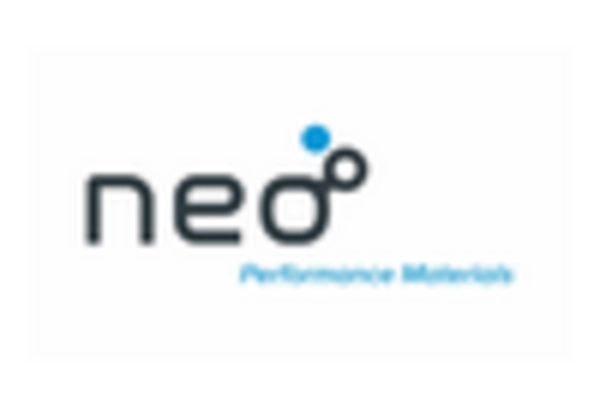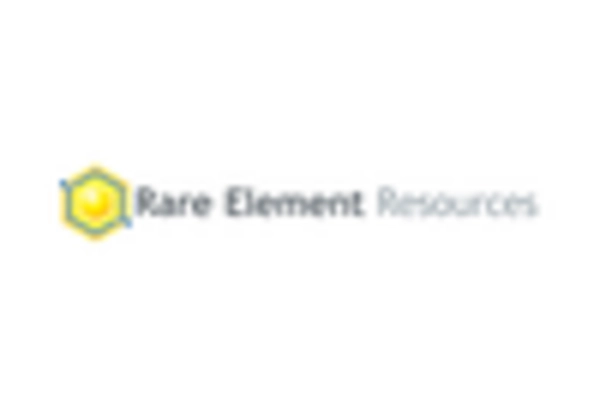Renewable Energy Technologies
The transition towards renewable energy technologies is a crucial driver for the Rare Earth Elements Market. Wind turbines and solar panels, which are integral to sustainable energy solutions, require rare earth elements for their efficient operation. For instance, neodymium is essential for the powerful magnets used in wind turbine generators. In 2025, the renewable energy sector is projected to expand significantly, with investments in clean energy technologies expected to reach unprecedented levels. This growth is likely to increase the demand for rare earth elements, as manufacturers seek to optimize energy production and storage solutions. Furthermore, as countries commit to reducing carbon emissions and enhancing energy security, the reliance on rare earth elements in renewable energy applications will likely intensify. Thus, the Rare Earth Elements Market stands to gain from the ongoing shift towards sustainable energy practices.
Defense and Aerospace Applications
The defense and aerospace sectors are increasingly becoming significant contributors to the Rare Earth Elements Market. Rare earth elements are critical for various applications, including advanced missile systems, radar technology, and satellite communications. In 2025, defense spending is anticipated to rise, with many nations prioritizing the development of cutting-edge military technologies. This trend is likely to drive the demand for rare earth elements, particularly those used in high-performance alloys and electronic components. Additionally, the aerospace industry, which relies on lightweight materials and advanced composites, also utilizes rare earth elements to enhance performance and durability. As geopolitical tensions persist, the strategic importance of securing a stable supply of rare earth elements for defense applications becomes increasingly evident. Consequently, the Rare Earth Elements Market is expected to benefit from heightened investments in these sectors.
Increasing Demand for Electric Vehicles
The rising demand for electric vehicles (EVs) is a pivotal driver for the Rare Earth Elements Market. As automakers transition towards electrification, the need for rare earth elements, particularly neodymium and dysprosium, which are essential for manufacturing high-performance magnets in electric motors, escalates. In 2025, the EV market is projected to grow significantly, with estimates suggesting that over 30 million units could be sold annually. This surge in demand for EVs directly correlates with the increased consumption of rare earth elements, thereby propelling the market forward. Furthermore, the shift towards renewable energy sources, such as wind and solar, which also utilize rare earth elements, further amplifies this trend. Consequently, the Rare Earth Elements Market is likely to experience robust growth as the automotive sector increasingly prioritizes sustainability and innovation.
Emerging Economies and Industrial Growth
Emerging economies are playing an increasingly vital role in the Rare Earth Elements Market. As these nations industrialize, the demand for rare earth elements is expected to rise significantly. Countries such as India, Brazil, and Vietnam are investing heavily in infrastructure and technology, which often require rare earth elements for various applications, including electronics, automotive, and renewable energy. In 2025, the industrial growth in these regions is projected to contribute substantially to the overall demand for rare earth elements. Additionally, as these economies seek to enhance their technological capabilities, the need for advanced materials that incorporate rare earth elements will likely increase. This trend suggests that the Rare Earth Elements Market could experience robust growth driven by the industrialization efforts in emerging markets.
Technological Innovations in Electronics
Technological advancements in electronics are driving the Rare Earth Elements Market in profound ways. The proliferation of consumer electronics, including smartphones, tablets, and laptops, necessitates the use of rare earth elements like europium and terbium for producing vibrant displays and efficient batteries. In 2025, the electronics sector is expected to witness a compound annual growth rate (CAGR) of approximately 5%, which could lead to an increased demand for rare earth elements. As manufacturers strive to enhance product performance and energy efficiency, the reliance on these elements becomes more pronounced. Moreover, innovations in semiconductor technology and miniaturization trends further underscore the importance of rare earth elements in achieving superior functionality. Thus, the Rare Earth Elements Market is poised for growth as the electronics sector continues to evolve and expand.


















Leave a Comment